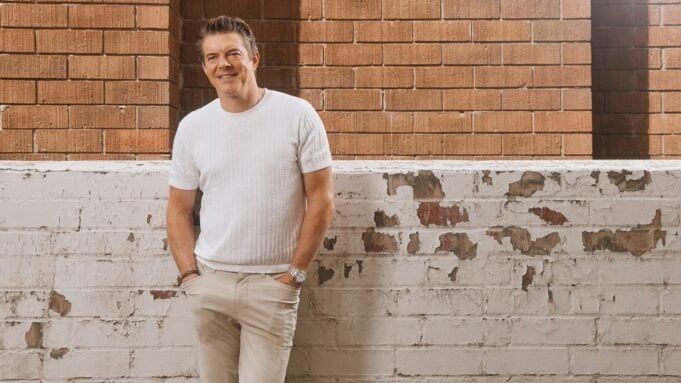Jason Blum plunges a shovel into some soft earth as two smiling murderers look on.
To his left is M3GAN, a homicidal AI doll who has spawned two movies. To his right is Babyface, a serial killer whose mask is the twisted likeness of a bucktoothed infant, star of “Happy Death Day” and its sequel. Blum tosses fresh dirt over his shoulder and continues to dig.
This is not a scene from one of the low-budget horror films that Blumhouse, his mold-breaking production company that marks its 15th anniversary this year, routinely churns out; it’s part of a photo op on a late September day in Estes Park, Colorado, where Blum is breaking ground on an expansion of the Stanley Hotel, which inspired Stephen King’s 1977 novel “The Shining.” Soon the resort will be the spooky setting of Blumhouse Space, a museum where Blum’s company will showcase horror-movie artifacts.
Not that Blum needs a museum to vouch for his place in Hollywood history. His low-budget slashers and supernatural chillers have sold more than $6 billion in tickets, making the company among the most profitable in the entertainment industry. Their titles are brands unto themselves: “Insidious,” “The Purge,” “Paranormal Activity,” “Five Nights at Freddy’s” and “The Black Phone,” for starters. Many of those movies are more popular with audiences than critics, but Blum has branched out. He produced the 2017 cultural juggernaut “Get Out,” scoring a best picture Oscar nomination, and has backed some arty left turns not suitable for Halloween, like “Whiplash” and “BlacKkKlansman.”

But this year has been a rough one for the hitmaker. In quick succession, Blumhouse released “Night Swim,” “Imaginary” and “M3GAN 2.0,” only to see them flop at the box office. At the same time, horror movies from rival studios, such as “Weapons” and “Sinners,” which were made by A-list auteurs like Zach Cregger and Ryan Coogler for tens of millions more than Blum typically spends, were zeitgeist-y smashes. It raises questions about whether Blum’s model of cheap scares is in peril.
And Blum suffered another setback recently — he lost out on an auction for rights to reboot “The Texas Chainsaw Massacre,” the 1974 classic about a group of teens who stumble on a family of Southern cannibals.
Love Film & TV?
Get your daily dose of everything happening in music, film and TV in Australia and abroad.
“We were in the mix. The deal isn’t closed, but we probably won’t get it,” Blum says, looking defeated for a moment in his Koreatown office complex in Los Angeles.
A24, the cool-kids indie film company, won the “Texas Chainsaw Massacre” bake-off with a creative team led by “Weapons” producer Roy Lee and Glen Powell. Mainly, Blum is bummed he won’t have a chance to revitalize a franchise that had run out of gas. “I like taking IP that people are cynical about and turning expectations on their head,” he says.
Yet Blum, 56, is ebullient even when confronting failure, gesticulating with his hands and feet (in matching Converse sneakers, each a different color). He can mourn Leatherface all he wants, but the walls of his office suite are decorated with many big kills.
“A studio is only as strong as its creative collaborators,” Donna Langley, Chairman of Universal Entertainment, tells Variety. “Jason has always been cutting edge, and it’s been remarkable to work alongside him more than a decade — now more than ever, to have partners with the foresight to innovate and the wisdom to evolve in the face of a changing industry landscape.”
Blum’s mantel will get even more crowded after the Producers Guild of America honors him with its prestigious Milestone Award this cycle, a prize that goes to someone who’s made a historic impact on entertainment (previous winners include Steven Spielberg, Donna Langley and George Lucas). “Horror’s New Wave,” a coffee-table book that surveys Blumhouse’s film library, will hit the stands this month. And over the next few weeks, Blum will release the highly anticipated sequels to “Five Nights at Freddy’s” and “The Black Phone,” which should restore his commercial luster.
But Blum isn’t ready to rest. He’s still in the trenches, mining film schools and social media to find new (and economical) directing talent and bringing fading horror figures back to life (Blumhouse recently closed a deal to reboot “Saw”). The company also expanded its scare factory, merging with Atomic Monster, the producer of “The Conjuring,” in 2024. Blum says he’s always been a “builder.”
“I met him at a diner circa 1991,” says Ethan Hawke, star of three major Blumhouse franchises, including “The Purge.” Blum’s footwear made an impression even in the early days.
“He was dating an ex-girlfriend of mine and walking around New York City in flip-flops like a total weirdo,” Hawke remembers. “I asked him what he did for a living, and he said, ‘I’m a producer.’ He was probably 21 years old. I met all these young people at the time who said they wanted to be famous actors or genius writers or big-shot directors. He was the first guy who said ‘producer,’ and he clearly wasn’t — he was selling real estate or something — but I loved that about him.”
Blum has never lacked for confidence, but he’s also candid about his mistakes. In a wide-ranging discussion tied to his company’s anniversary, he opens up about his recent box office struggles, the challenges facing Hollywood and his next act.
Horror has become so mainstream that people say it’s oversaturated. What do you think?
They’re right. This year it was. Everyone pulled back, and next year it won’t be. I’ve been through that cycle now about three times: A few horror movies make money, then everyone makes horror movies and then they don’t make money. Then everyone pulls back, and so it goes. No moderation. Hollywood is like Charlie Sheen.
So what’s working?
Intellectual property and sequels. Something that’s an experiential event. The biggest “Conjuring” movie of all time opened from our sister company, Atomic Monster, a few weeks ago. People are going to the things that they know.
But there is something really cool happening in horror right now, largely due to “Get Out”: When we started, horror was for weirdos; it was not for mainstream filmmakers. If you were the star directing student at NYU, you were making a movie for Sundance and you wanted Focus Features or Searchlight to buy it. Then you got in line for an Oscar and bigger dramatic movies. There were very few 20-year-olds aspiring to make horror movies. The opposite is now true. I credit Jordan Peele with this. The cool kids make horror movies now.
You got a lot of street cred this summer for openly talking about what went wrong with “M3GAN 2.0,” which failed to meet expectations.
This is probably true of all genres but specifically with horror today: In a post-COVID theatrical world, the hits are bigger and the bombs are bigger. The box office is still off 20% from where it was in 2019, which means fewer movies are getting a larger part of the pie. Also, I think because of current release windows, genre and original fare suffer the most. Yes, we’ve had two original horror movies work big this year — “Sinners” and “Weapons” — but only two movies broke through; you used to get six or seven. Now the market has to be perfect, and the movies have to be perfect.
Over your entire career, what failure was your greatest lesson?
The two biggest failures that sting, that I think about every day, are “Jem and the Holograms” and “The Hunt.” Those should’ve been hit movies. The great, exciting and horrible thing about the movie business is you can get everything right and still things don’t work. I think Jon M. Chu got everything right on “Jem and the Holograms,” and it didn’t work. And “The Hunt” got everything right, but fake news killed the movie. It broke my heart, because there was a false narrative that got attached to the movie that destroyed it. It was too bad, and it would’ve been a huge hit and have been great for the culture.
“The Hunt” was delayed in 2019 because of early reports that it was a battle movie pitting “blue states” against “red states,” which wasn’t the case. Would that movie get greenlit today in our political climate?
Well, no one who reported on the movie saw it or read the script at the time.
And would it get greenlit today? No idea.
After the attacks on late-night hosts and the affiliate removal of Jimmy Kimmel, Hollywood is having a larger conversation about political censorship. How do you feel?
Political censorship is bad. All free speech is good. But when you embrace free speech, it means you have to also embrace things you don’t want to hear or don’t like. Both sides are a little hypocritical about that. But free speech comes with feelings that can get hurt. Take the “Purge” series — those were incredibly political movies; some people were offended, and some people weren’t. The debate is how we grow and learn.
As father of M3GAN, what did you make of recent headlines about AI actress Tilly Norwood?
Whatever you feel about AI, it’s here to stay. It’s very important to use it ethically and legally, and for the studios and the guilds to protect the copyright of the artists. But if we in Hollywood stick our heads in the sand and don’t use it at all, we’re going to cede content creation to other people. The consumer does not care if what they’re looking at is AI. We’ve got to embrace it, but ethically and legally.
People say that Blumhouse’s legacy will be its idea to pair small budgets with big studio marketing. What did you see that no one else did 15 years ago?
I thought the ideal thing would be to make movies independently and have them released by studios. No one was doing that at the time, and that’s what “Paranormal Activity” was. Then we came very fast out of the gate with “Insidious,” “Sinister” and then “The Purge.” All examples of super low-budget indie movies released by studios.
It’s still in the DNA of Hollywood that if you have success, you need to then make way more expensive movies. Whether you’re a producer, an actor — especially if you’re a director. You had a hit with a $5 million movie at Sundance? You should do a $20 million movie for Searchlight! That never made any sense to me. I’ve made many mistakes in my career, but one thing I did right was not get tempted by this notion of making a more expensive movie after you had a huge hit.
How did you avoid the temptation?
I didn’t gravitate towards making a $60 million version of “Dracula” after “Paranormal Activity” — I made a $980,000 horror movie called “Insidious.” I was able to take all the benefits of low-budget filmmaking, which is just creative control. At Blumhouse, if you see a voice or a texture that runs through our movies, it’s what our low budgets allow: louder voices from the directors. The edges of our movies are much less sanded down than the big-budget movies.
The DPs, production designers and all the hardworking people who do craftwork around the movie won’t like to hear this, but I fundamentally believe that you can have a movie that doesn’t look good, isn’t lit well, but if the audience is really into the characters and what they’re saying, the movie can work. You could have the greatest-looking everything, but if the audience is not into what the actors are saying to each other, the movie doesn’t work.
You’ve never wanted to step up and direct a horror movie?
I couldn’t. I couldn’t focus on one thing that long.
How has the wave of Hollywood mergers and acquisitions affected Blumhouse?
I talk all the time about the larger media business, and it definitely trickles down to us, but it’s out of our control. I mean, my view on it is that we’re not really consolidating; it’s just become a different set of players. There were seven studios, and now it’s four studios with three tech companies.
The more relevant thing — which I think about a lot — is, are people going to watch less TV and fewer movies and move more towards YouTube and TikTok? But there’s nothing you can do about it.
Is Blumhouse for sale? I’ve been hearing it is for three years.
Blumhouse is not for sale.
You’re sure? There’s no sales deck circulating?
I can tell you with great certainty there is no deck, no banker hired. The biggest thing we’ve ever done in 15 years is merged with Atomic Monster. That’s been our biggest transaction, and I’m happy with how it’s going. Atomic Monster is incredibly well suited to the IP event business that really represents modern studio horror. I don’t think any company is better positioned today. The average Atomic Monster movie has made about $260 million worldwide.
You’ve mentioned that shorter theatrical release windows are hurting horror. Why?
I have to start by saying I was a big proponent of day and date. I think I was very wrong. It was not good for the business. I learned the hard way, and I would prefer that the windows were at least consistent, because it’s very difficult for the consumer. I would love to see films [exclusively in theaters] for 30 days or something like that across the industry. But I’m so far away from that decision; I have very little impact on it. I have nothing to do with it. But I think windows are very important to protect the theatrical experience. And it’s worth protecting.

You just got the rights to the “Saw” franchise. What is the creative vision there?
It’s really hard to make 10 movies in a franchise — I don’t take that away from the original series’ producers. And I’m grateful to them for allowing us to continue. My creative outlook is what I always preach: Get the people who made the magic in the first place more involved. James Wan [the original director] will be hugely involved. That’s how we’re going to reinvent it.
Are you done with “Halloween”?
We don’t own the rights anymore. I had a three-picture deal. But I would do another “Halloween” movie.
What’s been your experience in the TV space?
We’ve been in it for about 10 years. We’ve done “Sharp Objects,” “The Jinx,” “The Normal Heart.” We won two Emmys.
You’re also producing Richard Linklater’s “Merrily We Roll Along.” He’s filming that over 20 years with the same cast. A Sondheim musical is a pivot for Blumhouse.
It’s a real pivot. We’re in it for 20 years. We’ve been doing it for five; we’ve only got 15 left. It’s right around the corner.
How does one even budget a film like that?
Magical thinking. We have a budget: Universal is funding the movie. The budget is just a guess. But the credit for that movie falls squarely in two places: first, Rick. It’s so fucking cool what he and the creative group are doing. But you have to give it to Universal — no financier would ever do that. Jimmy Horowitz loves musicals — we produced “Death Becomes Her” together. They really took a flier on this thing, and I believe it will pay off for all involved. It’s very unusual.
Where did the name Blumhouse come from?
I used to play basketball at Chelsea Piers with Ethan Hawke and my old friend Frank Whaley. I was a terrible basketball player and still am, and Frank called me Blumhouse. It stopped being a joke when we incorporated in 2009 and used that name for the company.
I’d always dreamed of being a producer of studio movies. I finally got to do that in 1999, which was “Tooth Fairy” with Dwayne Johnson. It’s the only movie I’ve ever really produced for a studio. All the things I thought would be great about producing a studio movie were horrible, but the distribution process was greater than I could ever imagine. We walked into Fox, and there were 150 people in a distribution meeting. They all had crazy-specific jobs — there was a person in charge of promotions at car dealerships.
What is your white whale in the genre space — the movie you’d kill to make?
“Friday the 13th” and Freddy Krueger, those are my two white whales.
And they’re both locked up somewhere else?
We’re always haggling. I make a run at them every day. I will never give up the quest. And if they make one without me, I’ll chase the next movie.
And what about M3GAN? Is she done?
M3GAN will ride again. I’ll find a way.

From Variety US































